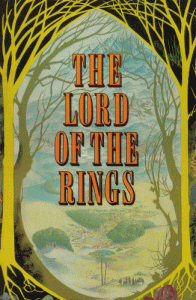
Having digressed massively from my initial inspiration – Margaret’s posts on books she’s loved – this post brings me back, in a round-about way, to literature.
Before it does, however…
I’ve recently been enjoying listening to the old 1968 BBC Radio 4 adaptation of The Hobbit, with Paul Daneman as Bilbo, and the delightfully named Heron Carvic as Gandalf.
I love Michael Hordern as Gandalf, in the later BBC R4 LOTR, preferring him and the series as a whole to Peter Jackson’s cinematic blockbuster vision. Curmudgeonly Tolkien snob that I am, I’m a bit miffed by the mainstream popularisation the Jackson films have brought about.
Heron Carvic and Paul Daneman are, for me, much closer in vibe to my initial childhood imaginings. And the music in this earlier Tolkienian adaptation – some of Stephen Oliver’s stuff in the aforementioned BBC R4 LOTR is sublime – just totally hits the sweet spot for me.*

But back to the literature: one of the qualities so attractive to me in Tolkien, masterfully summed up on the back cover blurb of my original childhood edition of LOTR, is the marriage of ‘the epic and the homely’. And these qualities remain, despite the passage of much time, both generally historically, and for me personally since first readings, at the heart of what enchants me in Tolkien’s writings.
And then there are, scattered liberally throughout his work, many little epithets replete with a homely wisdom, as when Gandalf admonishes Frodo thus: ‘All we have to decide is what to do with the time that is given us’. Or ‘Many that live deserve death. And some that die deserve life. … do not be too eager to deal out death and judgement. For even the very wise cannot see all ends’.

On the debit side, there are also times when certain characters make pronouncements I find less attractive or understandable. Another example, from Gandalf again, is when he says to Saruman ‘He that breaks a thing to find out what it is has left the path of wisdom’.
Whilst the first two of the above wizardy quotes do indeed seem wise, the third sounds like religious conservatism when it attacks science. That old unweaving the rainbow chestnut, methinks. Still, as the winter nights draw in, it’s the perfect time to hunker down beside the fire, and bathe in that ancient storytelling magic at which Professor Tolkien so excelled.


The Hobbit is a great autumn/winter treat of a read. As is the LOTR. But the latter, being such an enormous epic, involves an investment of time – and having read it multiple times in my youth – I can’t manage right now. So I’m considering re-reading my ‘First Edition’ style reissue, of The Hobbit.
Tolkien’s heirs have worked on completing some of their father’s larger unfinished projects, and there are some, such as The Children of Hurin, which are really rather wonderful. I originally read a good number of these in their incomplete form in a book called Unfinished Tales.
Christopher Tolkien in particular has done an amazing job of finishing some such works. So I quite fancy reading another of these, which I first encountered as Of Tour, and His Coming to Gondolin, subsequently completed and published now as The Fall of Gondolin. Another similar work has appeared telling the tale of Beren and Luthien. Rather sweetly, Tolkien and his wife have these names engraved on their headstone!

* It’s really rather quite odd stuff, composed by David Cain, and played by Andrew Munrow and the Early Music Consort. This music really does sound otherworldly. And that’s wherein the magic of it lies. Donald Swan’s Tolkien sanctioned ditties, by contrast, sound to me like horribly dated Victorian or Edwardian parlour music baubles.
